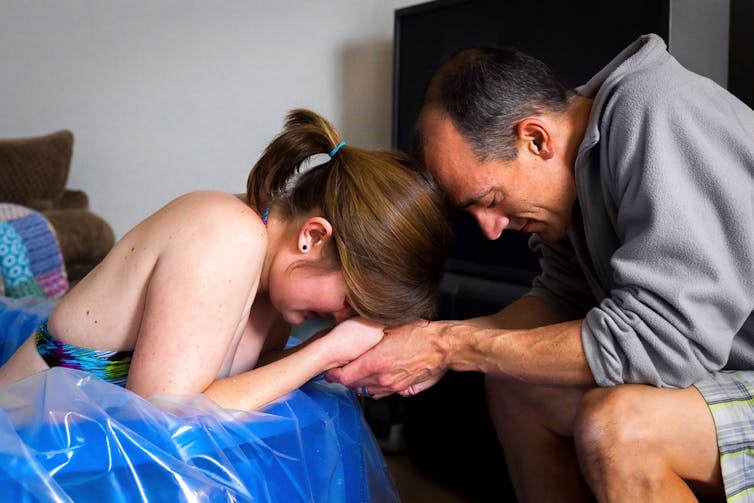During COVID-19, women are opting for 'freebirthing' if homebirths aren't available. And that's a worry
- Written by Hannah Dahlen, Professor of Midwifery, Associate Dean Research and HDR, Midwifery Discipline Leader, Western Sydney University
The pandemic is prompting some Australian pregnant women to give birth at home without a midwife or registered health provider, according to a survey out this week. Another new survey helps explain why.
The number of women who say they have either had or were thinking about “freebirthing” is concerning, due to the increased risk to mothers and babies when unrecognised complications arise or emergencies occur.
So we need to support women to choose where they give birth, or they may be forced to choose this riskier option.
Read more: Explainer: what are women's options for giving birth?
How many women are changing their birth plans?
The evidence to date indicates the risk of COVID-19 for pregnant women and babies is not as high as other groups. But women have understandably been concerned.
This has led to a spike in inquiries from women wanting to change where they give birth. We see this trend, from hospital to home, in Australia and overseas.
For instance, in Victoria a publicly funded homebirth program tripled the number of homebirths provided from March to May compared to the previous year.
Read more: So your birth didn't go according to plan? Don't blame yourself
Now, a national survey the Australian College of Midwives conducted during the peak of the COVID-19 pandemic provides further evidence.
Out of 2,750 responses from women about their experience of maternity care, 26% reconsidered where they wanted to give birth and who provided their care.
Reasons ranged from fear of contracting COVID-19 in hospital to restrictions on support people allowed in hospital for pregnancy, birth and postnatal care.
Most of those who reconsidered their maternity care looked for a homebirth option. But of those who wanted a home birth, 60% couldn’t find a private midwife, and 39% found they were fully booked. Around 3% chose to freebirth.
Why do women choose to homebirth or freebirth?
We have just published the results of the largest survey in Australia examining why women choose to give birth at home. We conducted this survey before the COVID-19 pandemic, with 1,681 women responding.
Most women said they wanted to give birth at home with a midwife. But nearly half said they would consider a freebirth or finding an unregulated birth worker if they could not have a midwife. One in ten women had a freebirth.
Read more: Episiotomy during childbirth: not just a 'little snip'
Reasons for wanting to give birth at home included wanting to avoid medical interventions, such as induction of labour or episiotomy, or to avoid feeling pressured to have them, rather than being supported to have the birth they wanted.
Many of the women who responded to the survey described their previous hospital experience as traumatic (32%) or were diagnosed with post-traumatic stress disorder (6%).
Are homebirths safe?
In Australia only 0.3% of women are able to access a homebirth attended by a midwife.
This contrasts with other countries such as the Netherlands (12.7%) UK (2.1%), Canada (2%) and New Zealand (3.4%) where this birth option is funded and supported for low risk women by government and key obstetric colleges, such as those in the UK and Canada.
In Australia the obstetric college RANZCOG advises against homebirth.
Yet reviews published in 2018, 2019 and 2020 find strong evidence for the safety of a homebirth for low risk women with a midwife attending.
 Having a homebirth with a midwife is more common overseas. So why not in Australia?
from www.shutterstock.com
Having a homebirth with a midwife is more common overseas. So why not in Australia?
from www.shutterstock.com
Why aren’t there more homebirths in Australia?
There are many reasons for the lack of support for homebirths in Australia. These include medical opposition, lack of insurance for private midwives to attend a homebirth and lack of Medicare funding.
Women who live within 20-30 minutes of one of the 17 publicly funded homebirth programs (run out of public hospitals) and remain low risk, can birth at home. But these programs are oversubscribed and inaccessible to many women, especially in non metropolitan areas.
Others will try to find one of around 200 private midwives nationwide, who are not already fully booked, to care for them. They will pay up to A$6,000 for a private midwife to attend a homebirth, getting no Medicare rebate for the birth at home and little chance of private insurance rebates.
COVID-19 has escalated this demand for homebirth even further.
Here’s what we can do
We have written extensively about the reasons why women choose freebirth, and engage non regulated providers such as birth workers.
So we need to support women to choose where they give birth and not to be forced into less-safe options. Here’s what would make a difference:
make respectful care a reality for all women, to reduce birth trauma in the first place
support women’s access to their chosen place of birth and model of care
support midwifery care at home through funding and insuring midwifery care
offer more flexible, acceptable options for women experiencing risk factors during pregnancy and/or birth
get the policy, regulatory and educational framework right to enable safe and sustainable homebirth services.
Heather Sassine was the lead author of the study and undertook the survey as an honours student in the School of Nursing and Midwifery at Western Sydney University.
Authors: Hannah Dahlen, Professor of Midwifery, Associate Dean Research and HDR, Midwifery Discipline Leader, Western Sydney University





